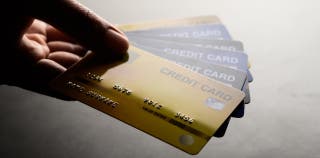How long does it take to raise your credit score?
There are plenty of strategies you can use to keep your credit score in the best possible shape.
These include making all required payments early or on time, keeping debt levels low, and refraining from opening or closing too many new accounts.
The opposite is also true. After all, late payments, too much debt, and too much new credit can cause your credit rating to drop in a hurry.
Certain credit mishaps and moves take more time to recover from than others. For example, a new hard inquiry on your credit report can have a negative impact on your score for a few months, whereas a 30-day late payment on your mortgage can take nine months to three years to overcome, according to data from FICO.
Of course, some mistakes with credit can take even longer than that to recover from. Reporting from FICO shows that a consumer with a credit score of 780 who files for bankruptcy may not see their score fully rebound for seven to 10 years. That said, the same consumer who files bankruptcy with a 680 credit score may see their score reach that level again in just five years after filing.
By and large, the length of time it takes to increase your credit score will depend on why you have bad credit in the first place. Do you have too many new credit accounts? Or, have you been making late payments? Perhaps your credit utilization ratio is far too high, or you have a history of delinquencies or charge-offs.
Ultimately, these factors and others will determine how long it takes you to get your credit score back in good shape.
Steps to improve your credit score
Whether you have too much credit card debt, you made student loan payments after their due date, or you had a bad experience with an authorized user on your credit card, the following steps can help you remedy the situation. Keep in mind that applying for a student card can help students learn about good spending habits which can help them qualify for credit and student loans.
Here’s the good news: The steps you need to take to increase your credit score are pretty much the same regardless of where you’re at in your credit journey.
1. Pay all your bills on time
According to MyFICO, your payment history is the most important determinant of your FICO score at 35%. With this in mind, you should do whatever it takes to ensure all your bills are paid on time, even if you have to set up some bills on autopay or pay all your bills on a certain day of the month.
If you have credit cards that let you select your payment due date, planning these dates around the days you get paid can help. As a cardholder and consumer, you’ll want to do everything you can to avoid late payments at all costs.
2. Ask for late payment forgiveness
If you have made a late payment on a credit card bill or any other bill you owe, it may be possible to have the late payment removed from your credit reports or not reported at all. To ask for forgiveness, you’ll want to call the credit card issuer or lender.
They may remove the information or not report a late payment if you call and ask, especially if you have a long history of responsible credit use before that. Either way, the worst that can happen is them saying “no.”
3. Lower your credit utilization rate
The second most important factor that makes up your credit score is how much debt you have in relation to your credit limits, or your credit utilization.
This factor is impacted the most by revolving debt you have, such as credit card debt. However, other credit accounts like auto loans, student loans, lines of credit, and personal loans also play a role.
To lower your credit utilization rate, you’ll want to pay down debts you have, starting with high-interest credit card debt.
Most experts recommend keeping your credit utilization ratio below 30% for the best results, which translates into having $3,000 in credit card balances or less for every $10,000 in available credit you have. You may see an even greater impact on your score if you use 10% of your available credit or less.
4. Apply for a new credit card
Applying for a new credit card can result in a hard inquiry on your credit report with Experian, Equifax, and TransUnion. While asking for new credit can ding your score a few points right off the bat, the negative impact of a new hard inquiry tends to last just a few months.
Meanwhile, applying for a new credit card increases the amount of available credit you have. This can lower your credit utilization ratio automatically, which can help boost your score.
5. Request a credit limit increase
Another instant way to lower your credit utilization rate involves asking your current lender for a credit limit increase.
This works best when you have a credit card that’s in good standing. If you currently have a credit limit of $5,000, calling your card issuer and asking for a credit limit increase to $10,000 can help.
Here’s an example of how a credit limit increase can improve your debt-to-income ratio overnight. Imagine you currently have $2,000 in credit card debt on a card with a $5,000 limit. This means your current utilization is at 40%. By getting your card issuer to increase your credit limit to $10,000, your utilization drops to 20% right away.
6. Add rent and utilities to your credit report
You can also add rent and utilities to your credit report by signing up for a program called Experian Boost. This app will only help increase your credit score with Experian (and not with Equifax and TransUnion), but it’s still entirely free and can make a major impact.
Not only does this app let you get credit for rent and utility payments, but you can also add subscriptions you pay to your account and build credit that way. This helps you show a history of on-time payments on your credit reports, and it can also help improve your credit mix.
If you need help with credit-building because you have no credit history at all, you can also look into a program called Experian Go. This program lets you create your Experian credit report based on payments you’re already making, and it’s absolutely free to use.
7. Take out a credit-builder loan
If you have bad credit or barely any credit history, taking out a credit-builder loan can help with credit-building.
These loans, which are offered through companies like Self, let you make payments toward a savings account in your own name. These payments are then reported to the credit bureaus, which helps you build a history of on-time payments.
At the end of the process, you get the funds in your savings account returned to you, minus a small amount in interest charges and fees.
8. Sign up for a secured credit card
A secured credit card can also help with credit-building, although these cards don’t work exactly as unsecured credit cards do.
Secured credit cards require a cash deposit as collateral, which usually starts at around $200. This deposit lets you secure your own line of available credit, which you can use to make purchases. From there, your monthly payments and balances are reported to the credit bureaus, so you get the chance to prove your creditworthiness over time.
While putting down a cash deposit on a credit card may not sound ideal, you can get your deposit back when you close or upgrade your secured card in good standing.
9. Resolve debts in default
If you have a credit card account in default or other delinquencies on your credit report, paying them off can have a significant impact on your FICO credit score or VantageScore.
After all, negative reporting like late payments and charge-offs can stay on your credit report for up to seven years otherwise, according to Equifax.
If you have a credit card account in default or other delinquencies on your credit report, paying them off can have a significant impact on your FICO credit score or VantageScore.
After all, negative reporting like late payments and charge-offs can stay on your credit report for up to seven years otherwise, according to Equifax.
If you want to have a good credit score, you’ll also need to check your credit reports from time to time.
This step can help you spot the early signs of identity theft, such as accounts you don’t recognize that were opened in your name. However, checking your reports can also help you uncover credit reporting mistakes that may be hurting your score.
Either way, you can check your reports with Experian, Equifax, and TransUnion for free using the website AnnualCreditReport.com. From there, you can check for incorrect information that may be making your bad credit even worse.
According to the Consumer Financial Protection Bureau (CFPB), some of the most common credit reporting errors that could be hurting your score include closed accounts reported as open, accounts that are incorrectly reported as late or delinquent, debts incorrectly listed more than once, and accounts with incorrect limits or balances. Fortunately, the Federal Trade Commission (FTC) offers insights and guidelines on how to dispute incorrect negative information on your credit reports so you can begin working toward a good credit score right away.
The bottom line on improving your credit score
Whether you’re a borrower who wants to take out a car loan or you hope to purchase your dream home one day, you need a good credit score.
After all, your score is used to determine whether you can get approved for credit at all, and it also impacts the interest rates and fees you’ll pay.
Wherever you are in your credit-building journey, you should begin taking calculated moves today that can get you where you want to be. You can work with a credit repair company to begin building your credit score, but you can also do it on your own by following the steps we’ve outlined in this guide.
Whatever you decide, you should know that the long-term benefits of maintaining good credit are worth the effort.























































































































